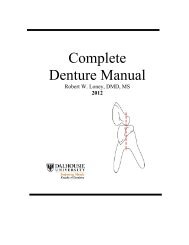RPD Manual 11 - Removable Prosthodontics - Dalhousie University
RPD Manual 11 - Removable Prosthodontics - Dalhousie University
RPD Manual 11 - Removable Prosthodontics - Dalhousie University
You also want an ePaper? Increase the reach of your titles
YUMPU automatically turns print PDFs into web optimized ePapers that Google loves.
Direct and Indirect Retainers - 51<br />
necessary flexibility in the clasp arm. The clasp is usually cast and is placed just below the<br />
height of contour line.<br />
5. On premolars, the proximal plate should extend lingually so that the distance between<br />
the proximal plate and the mesio-occlusal rest is less than the mesio-distal width of<br />
the tooth. The proximal plate in conjunction with the mesial rest (and minor connector)<br />
acts as the reciprocating element of the clasp and prevents the lingual migration of the<br />
tooth when the clasp arm moves over the height of contour.<br />
6. On cuspids, the minor connector cannot be used for reciprocation since it does not contact<br />
the tooth until after the retentive element has passed across the height of contour and the<br />
partial denture is seated. This is because the mesio-lingual rest is located fairly low on the<br />
cingulum of the tooth. Therefore, the I-bar is located in the mesio-buccal undercut and<br />
is reciprocated directly by the proximal plate.<br />
7. The guiding plane is a parallel surface prepared on the occlusal one third of the distal<br />
surface of the tooth. The guiding plane extends lingually enough so that, along with the<br />
mesial rest, it can prevent lingual migration of the tooth. It is approximately 2 to 3 mm in<br />
height.















